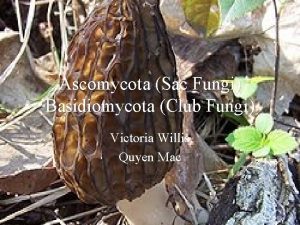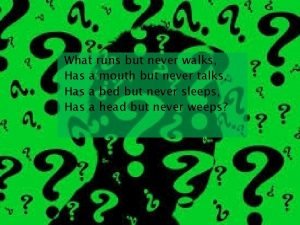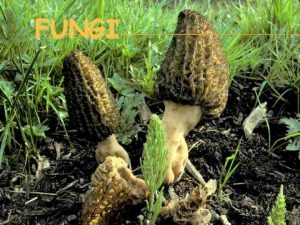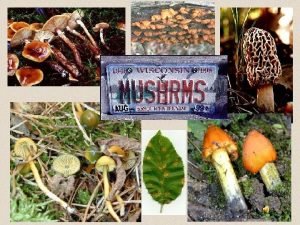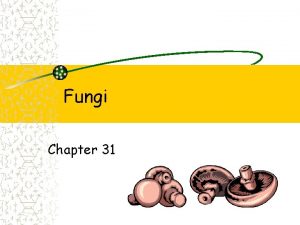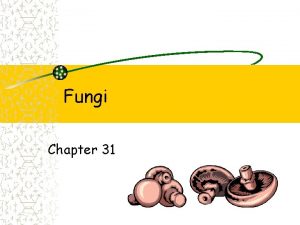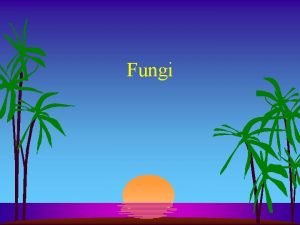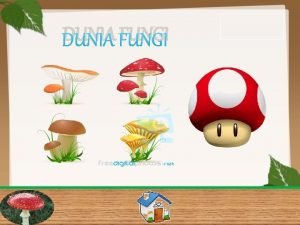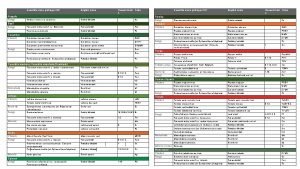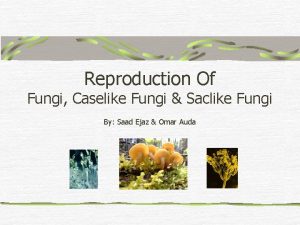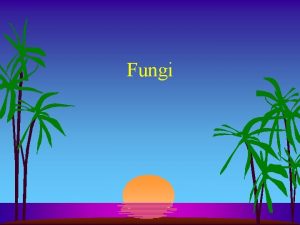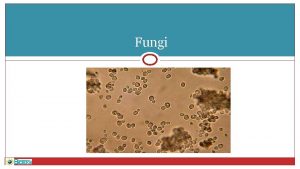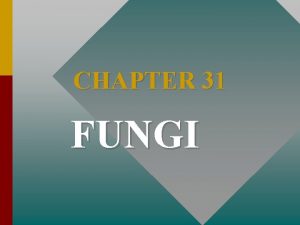Fungi and fungirl that joke never gets old




















- Slides: 20

Fungi (…and fungirl – that joke never gets old…)

Characteristics • Fungi are eukaryotic, nonphotosynthetic organisms that can be unicellular or multicellular in form. • Fungi are divided into four groups depending on their characteristics • Deuteromycota • Zygomycota • Ascomycota • Basidiomycota

Obtaining Nutrients • Fungi are among the most important decomposers of organic matter. • Fungi are saprobes, they obtain nutrients by secreting enzymes and absorbing simple organic molecules from their environment.

Structure of Fungi • Fungi are made up of short filaments called hyphae. – Mats of hyphae are called mycelium. – Some species have partitions called septa in their hyphae, making individual cells. • Fungal cell walls contain chitin rather than cellulose, which is found in plant cell walls.

From The Fungi Name Trail by Liz Holden & Kath Hamper

Decomposers! Yay! • They grow on organic matter then secrete enzymes outside of their bodies that digest this organic matter. • Without saprobes and heterotrophic bacteria, communities would be buried in their own garbage. • Next they absorb the digested organic matter. • Without nutrient recycling life could not go on. • This decomposition releases nutrients back into the ecosystem.

Reproduction • Most fungi reproduce both asexually and sexually. • Spores are the reproductive cells

Asexual Reproduction • Asexually, fungi produce thousands of genetically identical haploid spores, usually on modified cells of the hyphae. • When these spores are placed in favorable environmental conditions, they germinate and grow new hyphae, each of which can form a mycelium and produce thousands of new asexual spores.

Sexual Reproduction • Fungi occur in mating types that are sometimes called minus and plus. • When two different mating types of the same species encounter one another, the hyphae of one mating type fuse with the hyphae of the opposite mating type. • These fused hyphae give rise to a specialized structure, which produces and scatters genetically diverse spores.

Types of Fungi The four major groups of fungi are: 1. Common molds (Zygomycota) 2. Sac fungi (Ascomycota) 3. Club Fungi (Basidiomycota) 4. Imperfect fungi (Deuteromycota) The classification is made according to their structures and method of reproduction.

Common Molds (Zygomycota) • Phylum includes the familiar molds that grow on meat, cheese, fruit, and bread. • They produce spores in round spore cases called sporangia. When the sporangia split open hundreds of spores are released into the air. Each spore will develop into a new mold if there is enough moisture, food, and warmth. Mold on an orange

Sac Fungi (Ascomycota) • Examples of these fungi are yeast, molds, morels, and truffles (yum). Truffles (about $1000 worth) • The phylum Ascomycota is named for the ascus, a tough sac that contains spores.

Club Fungi (Basidiomycota) • The phylum Basidiomycota gets its name from a specialized reproductive structure that resembles a club. • The spore-bearing structure is called basidudium

Club Fungi Examples Mushrooms Shelf fungi Coral fungi Puffballs

Imperfect Fungi (Deuteromycota) • Fungi that do not have a sexual stage are classified in a group called fungi imperfecti, or deuteromycota. They can’t reproduce sexually. • Deuteromycota examples are Penicillium, ringworm, athlete's foot fungus, tomato blight fungus, and cucumber scab fungus.

Some “Fun”gi Facts

World's Largest Organism • Armillaria ostoyae – honey mushroom • Ascomycete • 3. 5 miles across and takes up 1, 665 football fields. • Located in Malheur National Forest in Eastern Oregon • 2400 -7200 years old

Fairy Rings • Clusters of mushrooms are often part of the same mycelium. • Some mycelium live for many years. As time goes by the soil nutrients at the center of the mycelium become depleted. • New mushrooms sprout on the edges producing a ring.

Salem Witch Trials The Salem Witch Trials of 1692 saw the arrest of some 250 persons suspected of witchcraft. Ergot is a fungus of rye grass. It grows best in wet conditions. Ingestion of infected rye can cause feelings of numbness, or suffocation – symptoms which in the past might have been interpreted as bewitchment or possession by the devil.

Could ergotism have contributed to the Salem Witch Trials? • Rye was grown in Essex county in the late seventeenth century. • 1692 was a high moisture year, necessary for the growth of ergot. • 24 of the 30 victims experienced fits and hallucinations along with the sensation of being pricked or bitten • Others reported feeling a burning sensation in their fingers, lameness or temporary blindness. • All of these could be symptoms of ergotism.
 Complete the sentences using simple present tense
Complete the sentences using simple present tense Phân độ lown
Phân độ lown Block nhĩ thất cấp 1
Block nhĩ thất cấp 1 Thể thơ truyền thống
Thể thơ truyền thống Thơ thất ngôn tứ tuyệt đường luật
Thơ thất ngôn tứ tuyệt đường luật Chiến lược kinh doanh quốc tế của walmart
Chiến lược kinh doanh quốc tế của walmart Tìm vết của đường thẳng
Tìm vết của đường thẳng Hãy nói thật ít để làm được nhiều
Hãy nói thật ít để làm được nhiều Tôn thất thuyết là ai
Tôn thất thuyết là ai Gây tê cơ vuông thắt lưng
Gây tê cơ vuông thắt lưng Sau thất bại ở hồ điển triệt
Sau thất bại ở hồ điển triệt Basidiomycota club fungi
Basidiomycota club fungi Your love never fails you never give up on me
Your love never fails you never give up on me We are never never weary
We are never never weary If we had more rain our crops would grow faster
If we had more rain our crops would grow faster He never polishes his shoes so he never looks smart
He never polishes his shoes so he never looks smart God never fails
God never fails What can run but never walks has a mouth
What can run but never walks has a mouth Haustorium in fungi
Haustorium in fungi Club fungi are morels truffles bracket fungi yeast
Club fungi are morels truffles bracket fungi yeast Old heroes never die
Old heroes never die











